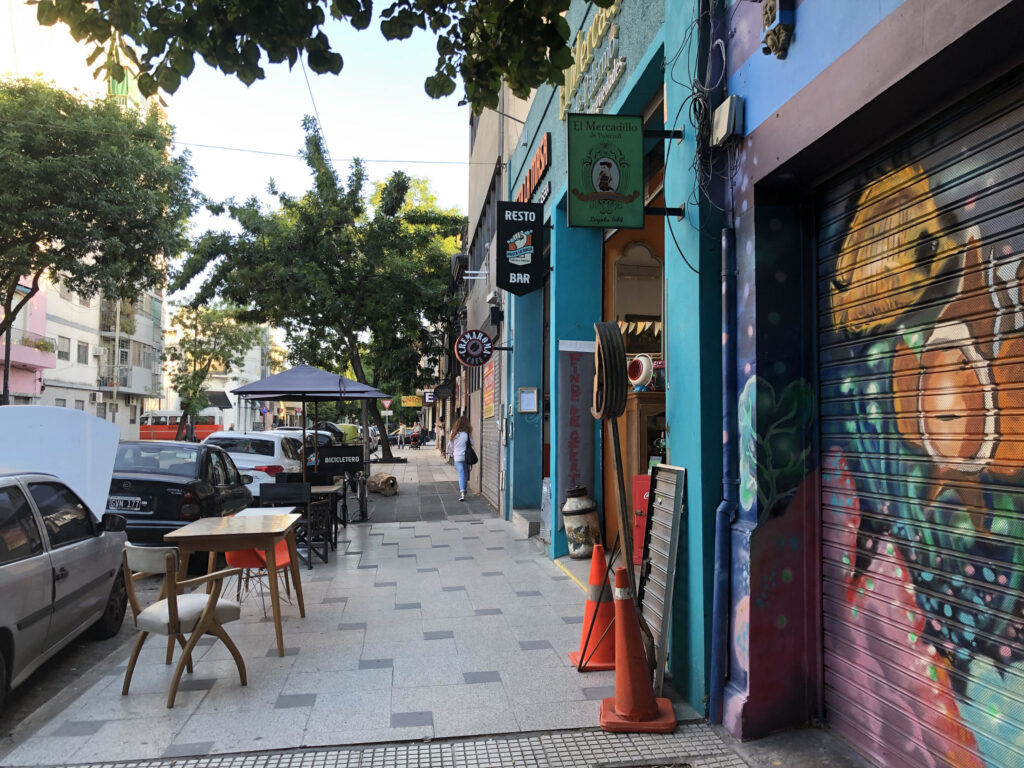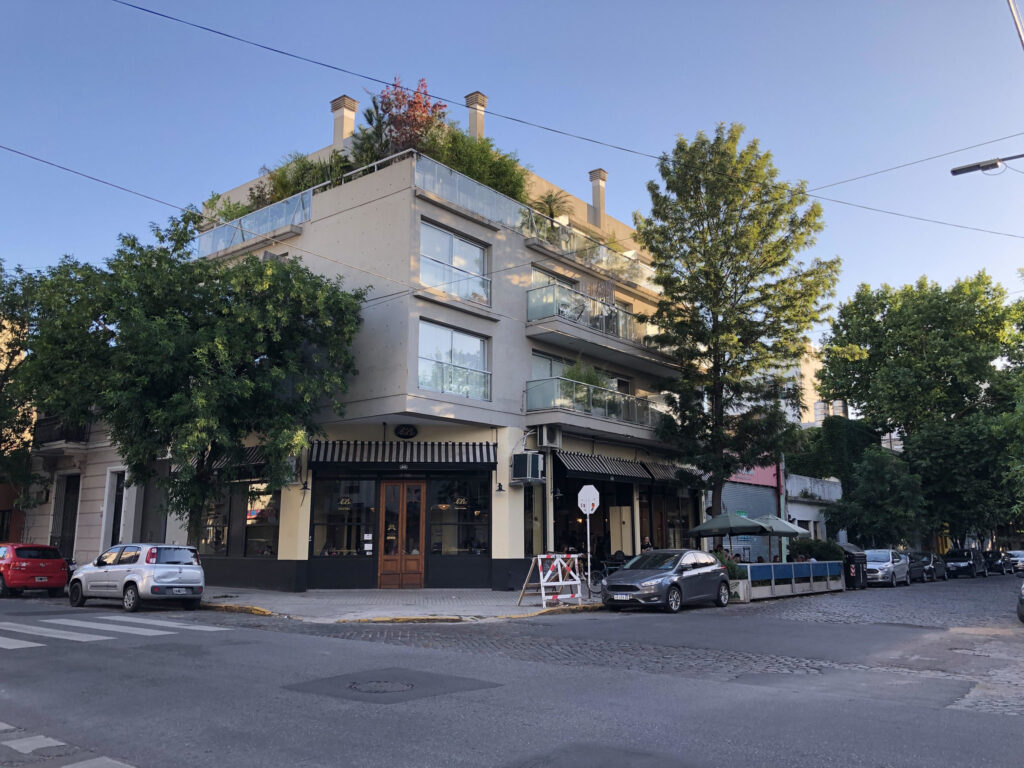Villa Crespo, a neighborhood that might slip under the radar for the average tourist, is actually the most bohemian and quintessential middle-class area of Buenos Aires.
Known for its accessible cost of living, strategic location close to all parts of the city, and excellent transportation links, Villa Crespo offers its residents the best of both worlds. The neighborhood’s tranquility coexists with a booming commercial, real estate, and culinary scene that is gradually reshaping its character.
In this article by ExpatPathways, we explore everything you need to know about Villa Crespo, perfect for digital nomads, travelers, and expats seeking an authentic Buenos Aires experience.
Villa Crespo (Buenos Aires): Everything You Need to Know About the Neighborhood
Basic Information About the Villa Crespo Neighborhood (Buenos Aires)
Although it is not the largest neighborhood in Buenos Aires, Villa Crespo covers a considerable area of 3.8 km². The anniversary of Villa Crespo is celebrated on June 3.
According to the latest national census (2022), Commune 15, which includes Villa Crespo, has a population of 197,903 residents.

Tradition and Culture
Villa Crespo has a rich tradition in Buenos Aires’ carnival, featuring renowned and well-attended parades with at least four murgas: Los Ansiosos De Villa Crespo, Los Movedizos de Villa Crespo, Centro Murga Maniáticos de Villa Crespo, and Los Dichosos de Villa Crespo.
Clubs and Social Hubs
Among the most representative clubs are Villa Malcolm, El Fulgor, Marqueé, La Cultura del Barrio, Club Villa Crespo, Club Cultural Matienzo, Club V, La Quince, and the most famous, Club Atlético Atlanta.
Food and Dining
The neighborhood is home to several notable eateries such as the pizzerias Angelin, Imperio (since 1946), il Migliore, El Padrino, and Nápoles.
Popular restaurants include Comander, Alé Alé, Los Bohemios at the Club Atlanta headquarters, Don Zoilo, Cantina A los Amigos, and several renowned grills like Don Jorge, La Luli, El Patio, Lo de Jaime, Salgado, Lo del Chuni, and Los Chanchitos.
The only kosher supermarket in the area is “100% Casher,” located opposite the ACISBA temple. Iconic lingerie shops Isaquito and Ricardo, located on Scalabrini Ortiz Avenue, are popular among locals for their long-standing presence.
Historic Bars
Among the bars is the century-old “San Bernardo,” where billiards players mix with pool players, and games of dominoes and generala are organized at the tables. Another historical bar is “Los Bohemios,” now demolished.
Many of these establishments were frequented by the writer Leopoldo Marechal, who lived in the neighborhood between 1910 and 1934 at Monte Egmont 280.
Notable Buildings
The neighborhood is also home to the “Conventillo de la Paloma,” which inspired the famous play by Alberto Vaccarezza. A plaque in honor of Vaccarezza was placed on the building at 156 Serrano Street by the Buenos Aires Legislature. The building has structural protection established by Law 1487 in 2004.
Other notable buildings include: The San Bernardo Parish, dating back to 1896; the Café, Bar Notable, and Billiards San Bernardo; the San Bernardo Market; La Alcaldía; the Odeón Conservatory; the Máspero Brothers Workshop; La Farmacia del Águila; the Dell’Aqua Factory Complex, among others.
Industrial Origins
Villa Crespo emerged along the Maldonado Stream, now tunneled under Juan B. Justo Avenue. In the late 19th century, the area’s waters were seen as a drainage solution for industrial fluids, attracting several manufacturing establishments.
Historical Growth
The foundation of the National Shoe Factory on June 3, 1888, spurred the leather industry. Most workers, predominantly Italian, lobbied for the new village to be named in honor of their patron, Saint Crispin. However, it was ultimately named after Saint Bernard in honor of the factory manager’s father, Don Salvador Benedit.
Population and Community
The increase in population led to constant commercial growth. Neighbors organized in institutions developed a high degree of social activity. From the rise of Tango Orillero, with the cultural addition of immigration, artistic expressions, and the bohemian atmosphere of its cafes, Villa Crespo reached its cultural peak in the 1940s.
In the early 1960s and 1970s, the neighborhood experienced an exodus of residents, leading to a decline in cultural activities and commerce. By its centennial in 1988, a group of dedicated residents began advocating for a better quality of life and reviving cultural activities. Their efforts have contributed to the resurgence of Villa Crespo.
In recent years, Villa Crespo has seen significant commercial and real estate expansion. This modernization has both positive and negative consequences, enhancing the neighborhood’s accessibility and economic activity while impacting its identity, history, and living costs for the middle class.
Where Is Villa Crespo Located?
Villa Crespo is a Buenos Aires neighborhood located in Commune 15, in the center of the Autonomous City of Buenos Aires, Argentina. It is bounded by the General San Martín Railway, Av. Dorrego, Av. Warnes, Paysandú, Av. San Martín, Av. Ángel Gallardo, Av. Estado de Israel, Av. Córdoba.
It borders the neighborhoods of La Paternal to the west, Chacarita to the northwest, Palermo to the northeast, Almagro to the southeast, Caballito to the south, and a small part of Villa General Mitre to the southwest.
This neighborhood is located in the heart of Buenos Aires and has historically been known for its tranquility and affordable cost of living.
Transport Network in Villa Crespo
Villa Crespo is a central neighborhood in Buenos Aires. This means you’ll be relatively “equidistant” both to the historic areas of Buenos Aires (San Telmo, Microcentro, Puerto Madero) and to the commercial zones.
In this sense, private cars, motorcycles, and bicycles are excellent mobility alternatives.
Regarding the bus system, Villa Crespo has several avenues and streets where bus lines run across the neighborhood. At the same time, Villa Crespo has the Juan B. Justo metrobus.
On Corrientes Avenue, which runs diagonally through Villa Crespo, you’ll find the B subway line. This is one of the most important subway lines in Buenos Aires, allowing you to travel from the northwest area of the city to Puerto Madero.
Additionally, at the northern border between Villa Crespo and Chacarita, you’ll find the San Martín railway, which runs from the Retiro neighborhood in Buenos Aires to the western part of Buenos Aires Province.
Green Spaces in Villa Crespo
The green spaces in Villa Crespo are neither large nor diverse. Unlike its neighboring barrio of Caballito, Villa Crespo has a much lower level of green spaces per inhabitant, which is a disadvantage when seeking recreation or fresh air.
Despite being a bohemian and traditionally middle-class neighborhood, Villa Crespo has undergone significant transformations in its constructions in recent years. Therefore, the absence of significant green spaces, beyond a few small plazas like Benito Nazar, is a deficit in Villa Crespo.
If you stay in Villa Crespo, the most important green spaces are located in Caballito or Chacarita, to the north or south. In these directions, you’ll find some of Buenos Aires’ most important parks: Parque Centenario in Caballito and Parque Los Andes in Chacarita.

Advantages of Living in Villa Crespo
- Villa Crespo is a typically bohemian and middle-class neighborhood, sharing some characteristics with neighborhoods like San Telmo and Palermo.
- Historically, it has been a refuge for artists and working-class people.
- Its location is valuable as it allows quick access to strategic corridors like Palermo, Recoleta, and the northern part of the city.
- Although originally a residential neighborhood with low houses, it is currently transforming into an area of towers and large real estate projects.
- Villa Crespo has an important sector of clothing stores near the Palermo neighborhood.
- If you’re looking for a central, quiet, and dynamic neighborhood that is also budget-friendly, Villa Crespo is a perfect option.
- Villa Crespo is well connected with the city’s transportation network. Therefore, even though it isn’t the closest area to the tourist and historical center of Buenos Aires, getting there from Villa Crespo is relatively easy.
Activities and Things to Do in the Villa Crespo Neighborhood (Buenos Aires)
Bars and Restaurants
Villa Crespo boasts an interesting gastronomic scene. This includes not only restaurants and bars, ranging from classic to modern, but also cafés and breweries.
In this neighborhood, you’ll find a lovely prelude to the gastronomic offerings in Palermo. From historic cafés like San Bernardo to international cuisine restaurants (Armenian, Italian, Spanish), bodegones, cantinas, and specialty cafés.
Shopping Tour
One of Buenos Aires’ most important shopping and street store areas is located in Villa Crespo. It centers around Córdoba and Scalabrini Ortiz Avenues, as well as the parallel or perpendicular streets.
What’s special about these stores? They offer most of the same shops you’d find in a shopping mall but in smaller establishments. Their prices are more convenient, and they often offer discounts and promotions on out-of-season items.
Explore the Neighborhood
Villa Crespo isn’t a neighborhood where you can identify major landmarks or buildings to visit, unlike San Telmo, Palermo, or Recoleta. For this reason, rather than taking a map and identifying strategic tourist spots (something you could do when looking for a restaurant or bar), you should take some time to walk its streets.
The history and charm of Villa Crespo, tinged with the bohemian and popular essence of Buenos Aires, are found precisely in its sidewalks, façades, and corners.
Villa Crespo: The Neighborhood of Clubs
Neighborhood clubs are associations that have offered recreational, sports, and social activities to the community for many decades. In these institutions, neighbors and friends gather to have coffee, share a meal, and enjoy a game of soccer, paddle tennis, or a board game.
The fate of neighborhood clubs in Buenos Aires has been mixed. While some have not survived economic crises, others have succumbed to large real estate projects that make it impossible to refuse offers for the land on which the clubs stand.
However, many neighborhood clubs remain in Villa Crespo, starting with the iconic Club Atlanta, which competes professionally in soccer and other sports. Here, neighbors and members gather to practice sports, chat, and share a coffee or meal.
It’s worth taking some time during your stay in Villa Crespo, or another neighborhood, to enjoy these lovely community scenes.
Last Considerations
Villa Crespo (Buenos Aires) is a neighborhood that perfectly encapsulates the city’s bohemian essence and middle-class vibrancy.
Whether you’re a digital nomad, traveler, or expat, Villa Crespo offers everything you need—from a thriving commercial scene and excellent transportation links to a rich cultural heritage and affordable living.
Ready to explore this hidden gem? Let ExpatPathways guide you through the ins and outs of Villa Crespo, ensuring you make the most of your time in one of Buenos Aires’ most captivating neighborhoods.
(Featured Image Source: Horacio Rodríguez Larreta/flickr.com)


